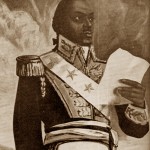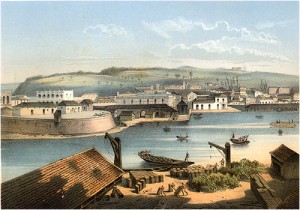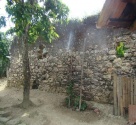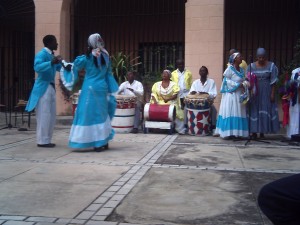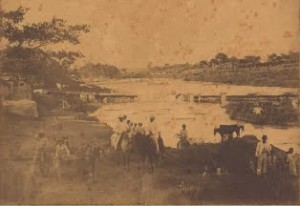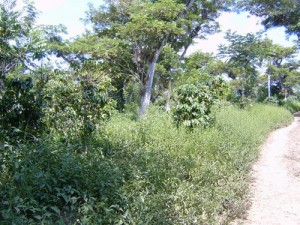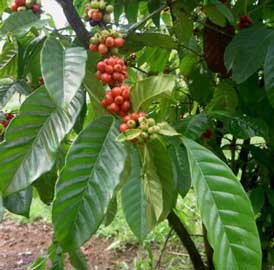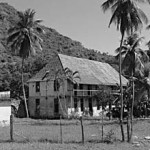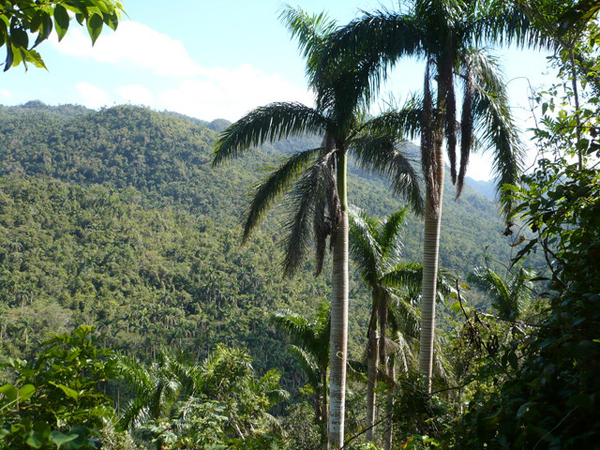At the beginning of the revolution in Saint Domingue in 1791 had multiple consequences for Cuba, but was a major influx of refugees. Many in the French part of Santo Domingo took refuge in Cuba since 1792. After the destruction of Cap Haitien in 1793, thousands of settlers began to leave the country that had welcomed them. It is known that already in the last five years of the eighteenth century in Santiago de Cuba was a discrete population of French from the American colonies. In fact, records show that on this date 918 Gauls lived there, most traders, settlers and craftsmen, many of whom were married to native of the region.
With the triumph of L’Ouverture arrived in Cuba in 1800 a new flow of immigrants, this time fleeing the slaughter, which was not arrested until the rebel general took over. It is known that already in the last five years of the eighteenth century in Santiago de Cuba was a discrete population of French from the American colonies. In fact, records show that on this date 918 Gauls lived there, most traders, settlers and craftsmen, many of whom were married to native of the region.
Between the period of the years 1800 to 1809, with the arrival of more than twenty-seven thousand individuals from all walks of the eastern territory was an extraordinary period of prosperity. Most French refugees remained in East Cuba, near Santiago. They brought their customs and usages, but also horror stories of rape, death, looting and destruction left in the imaginary Cuban a dread of slave uprisings. However, in their bags carried the most important thing for Cuban history were his technical knowledge, and capital. The economic development of Cuba at the end of s. Eighteenth and early nineteenth rested largely on the engineering and engineers who came from Saint Domingue, as there were not these on the island nor could bring Spain.
The largest producers of sugar mills in the late s. Eighteenth and early next were built by French engineers. Eight of the ten largest mills that ground the harvest of 1804 were built by the French. In others, the French introduced many technical improvements.
French immigration to the East created a belt of productive coffee plantations formed an arc around Santiago de Cuba. To the west, the south side to the French, the Upper Basin with Hongolosongo Cautious, Cautious Arm and Candelaria (261 km.), The Centre parties Botija, Melgarejo, the southern slopes of the Sierra de Boniato, including Guira, Dos Bocas and Shelters (160.5 km.) and east, the massif of the Gran Piedra, Dajao parties, Damajayabo and Zacatecas (192 km.). In 1806 a company of French settlers bought the farm where he was the rancheria of Santa Catalina, a little north of where it recognizes its current primitive settlement, this place was by the river Guaso near some “fast” the river in its confluence with a small stream named later Rafart, which gave name to the village soon, “Saltadero”.
Besides sugar production, this giant coffee production and the transition from the old sugar mill and obsolete by the most novel of wit. The success of this valuable immigration not long in coming. With a maximum of values produced by the commercial movement of the port of Santiago de Cuba. Between 1804 and 1807 the values produced by the port of Santiago de Cuba rose from 30,654 pesos to l55.753 pesos. In that period of time of 26.432 inhabitants and 7,449 were Spanish French to a total of 33,881 inhabitants.
Trade and Cultural Values
The period between 1800 and 1868 has been considered one of the most prolific in terms of French emigration in Eastern Cuba .. This meant more than just population growth on the island, a valuable entry into the country of culture, lifestyle and customs that would become an inseparable part of Cuban culture.
The Franco-Haitian settlers scattered through the mountains of southeast from the Sierra Maestra to Guantanamo were great farmers, entrepreneurs, businessmen and people of refined culture, who loved art and accustomed to live with comfort in their intricate estates. On their farms built large residences, furnished with luxury and surrounded by every comfort, pianos, libraries and often met in their properties to enjoy the festivities, theater, music, literary gatherings, etc..
The city of Santiago de Cuba, which by that date did not have sidewalks or paved streets and did not know the use of the lamp and lamps, are now affected by the lack of drinking water, supplies and space to contain big wave. newcomers but soon realized the favorable geographical conditions presenting this new land. Initially were directed mainly towards the port activities, and even came to temporarily trade the Catalans settled in the jurisdiction. With this rising population also achieved for the first and only time in the history of Santiago a relative balance between whites and blacks, there were some minor social changes such as opening a new pharmacy, enabling government buildings, facilitating the arrival of food and meat from other places or expansion of the posts of mail.
Already in 1804 there were three thousand men who cultivated the land unproductive. Were bought, sold and resold land to the pair that created economic projects with capital Creole, French and other nationalities. Combining these with the marine farming grew into an economic engine for Santiago.
For 1807, that Cuba exports coffee mainly to the United States and Spain, a report of Sebastian Kindelan, governor of Santiago, revealed the sum of five hundred thousand coffee plants whose production of ten million pounds could quadruple by 1810. But this boom would soon overshadowed. The war between France and Spain conditioned an order of the captain general of the island that forced into exile in Franco-Haitian and French residents. Certainly, this was not good news for Kindelan, who had seen the economic development achieved in a short time by their jurisdiction due to the tenacity and the French spirit.
Between 1818 and 1835 is located on the third flow of immigrants to Santiago de Cuba, supported by a Royal Order which sought to “whiten” the Cuban population. In this period should arrive around seven hundred and thirty one immigrants from the southwestern region of France. It is noteworthy that agriculture is not the economic magnet, with only 23% would be devoted to this work. Trade and port activities are now much stronger than in the previous period.
From 1821, some years after the treaty between Spain and England for the abolition of the slave trade, increases the slave trade and port Santiago became one of the most active in this regard, but also charges the force export of sugar, honey, honey, wax, coffee, snuff and rum. Shortly after mining is emerging as a new factor of economic development is even talk of a “mining fever” to refer to the new situation. In fact, some immigrants left farm work to pursue this promising sector of the economy.
In 1830, consolidating the first French economic society for mining, which will feature the best techniques for mineral exploitation and a large workforce, so it is among one of the most important economic sources of the period. Related companies also emerged stores store, stores, tailor shops, sales and other wholesale items, etc ….
The fourth and final flow of immigrants from France to Santiago de Cuba in the period dealt with is between 1836 and 1868. For the most part, came from the French Atlantic and recorded in a number of more than 2200. The economy is strengthened to the extent that immigrants are incorporated into the traditional sources of income. But go further. In 1851 the French promote a line of steamers for better communication between Santiago de Cuba and New York, there are new companies and companies engaged in the bakery trade in precious wood and railway development.
In July 1844 the French engineer Segebien place on the railway project of the Eastern Department, considered the first work of its kind in the region and intended to link the mines with the port Santiago. This and other engineers contributed heavily to the expansion of the railway, which was assigned a large part of capital of companies, especially from 1843 until 1861.
Coffee production remained at the top of agriculture over the sugar. It was in the forties when Santiago de Cuba reached its highest production of this grain, and when, near the end of it, began to decline, due to the failure of some farmers, the attraction depicting the farm of the copper deposits, like sugar production. But the great crisis of the coffee production in the region is marked by the beginning of the first war of independence.
This immigration of French bourgeois losers owe what was then the almost uninhabited regions of Guantanamo and the foothills of the Great House, in a few years used to promote a city like Guantanamo, nonexistent in the late eighteenth and center a prosperous region in the mid-nineteenth century, in a short historical period of just 50 years!
With the war of ten years (1868-1878) many of these estates and plantations disappeared, only ruins where there was a thriving farming, now hides the ruins fertile vegetation of the region, where you can overtake us in these mountains, stone walls of a rich mansion, the drying of coffee still in use, water mills, the remains of mills and mill machinery and the oral tradition after a history that remains alive in these mountain ranges of the “East High Cubano”
Sources: HistoriaGranInmigracion/InternetPhotos/A.Varona/TheCubanHistory.com
THE LONG HISTORY of a great Immigration.
The Cuban History, Arnoldo Varona, Editor
LA LARGA HISTORIA DE UNA RAN INMIGRACION.
Al inicio de la revolución en Saint Domingue en 1791 tuvo múltiples consecuencias para Cuba, pero una de las principales fue la llegada de refugiados. Muchos habitantes de la parte francesa de Santo Domingo se refugiaron desde 1792 en Cuba. Tras la destrucción de Cap Haitien en 1793, millares de colonos comenzaron a salír del país que les habia acogido con beneplacito. Se conoce que ya en el último quinquenio del siglo dieciocho existía en Santiago de Cuba una discreta población de franceses provenientes de las colonias americanas. De hecho, los registros muestran que por esta fecha vivían allí 918 galos, la mayoría comerciantes, colonos y artesanos, muchos de los cuales se hallaban casados con criollas de la región.
Con el triunfo de L’Ouverture en 1800 llegó a Cuba un nuevo flujo de emigrados, en esta ocasión huyendo de la masacre, que no fue detenida hasta que el general rebelde tomó el control. Se conoce que ya en el último quinquenio del siglo dieciocho existía en Santiago de Cuba una discreta población de franceses provenientes de las colonias americanas.
Entre el periodo de los años 1800 al 1809, con el arribo de más de veintisiete mil individuos de todas las clases al territorio oriental se produjo un extraordinario periodo de bonanza. La mayoría de los refugiados franceses en Cuba se quedaron en Oriente, en las inmediaciones de Santiago. Estos trajeron sus costumbres y usos, pero también terribles historias de violaciones, muerte, saqueo y destrucción, que dejaron dentro del imaginario cubano un pavor a las sublevaciones de esclavos. Sin embargo, en sus valijas lo más importante que transportaron para la historia cubana fueron sus conocimientos científicos y técnicos, y también capitales. El desarrollo económico de Cuba a finales del s. XVIII y principios XIX descansó en gran parte sobre la técnica y los ingenieros que llegaron desde Saint Domingue, pues no se contaba con estos en la isla ni los podía aportar España.
Los mayores ingenios productores de azúcar de finales del s. XVIII y principios del siguiente fueron construidos por ingenieros franceses. Ocho de los diez mayores ingenios que molieron la zafra de 1804 fueron construidos por franceses. En otros, los técnicos franceses introdujeron numerosas mejoras.
La inmigracion francesa hacia Oriente creo un cinturon de haciendas cafetaleras productivas que formaron un arco alrededor de Santiago de Cuba. Al Oeste, la vertiente sur hasta el francés, la Alta Cuenca del Cauto con Hongolosongo, Brazo del Cauto y Candelaria (261 km.); al Centro, los partidos de Botija, Melgarejo, la vertiente sur de la Sierra de Boniato, incluyendo la Güira, Dos Bocas y Enramadas (160.5 km.) y al Este, el macizo de la Gran Piedra, con los partidos de Dajao, Damajayabo y Zacatecas (192 km.). En 1806 una sociedad de colonos franceses compró la hacienda donde estaba el rancherío de Santa Catalina, un poco más al norte del lugar donde se reconoce su actual asentamiento primigenio, este lugar estaba junto al río Guaso cerca de unos “rápidos” del río en su confluencia con un pequeño arroyo nombrado posteriormente Rafart, que dieron pronto nombre al caserío, “Saltadero”.
Ademas de la produccion azucarera, esta gigantesca produccion cafetalera y la transicion del antiguo y obsoleto trapiche azucarero por el mas novedoso del ingenio. El éxito de esta valiosa inmigracion no se dejó esperar. Con un maximo de valores producidos por el movimiento comercial del puerto de Santiago de Cuba. Entre los años 1804 y 1807 los valores producidos por el puerto de Santiago de Cuba se elevaron de 30.654 pesos a l55.753 pesos. En ese plazo de tiempo 26,432 de sus habitantes eran españoles y 7.449 franceses para un total de 33.881 habitantes.
Comercio y Valores culturales
El período comprendido entre 1800 y 1868 ha sido considerado como uno de los más prolíferos en cuanto a emigraciones francesas hacia el oriente cubano.. Esto significó, más que un mero crecimiento demográfico en la Isla, de una valiosa entrada al país de elementos culturales, modos de vida y costumbres que llegarían a ser parte indisoluble de la cultura cubana.
Los colonos franco-haitianos se desperdigaron por la serranía del sur oriental desde la Sierra Maestra a Guantánamo, eran magníficos agricultores, emprendedores negociantes y gente de una cultura refinada, que amaban el arte y estaban acostumbrados a vivir con comodidades en sus intricadas haciendas. En sus fincas construyeron grandes residencias, amuebladas con lujo y rodeados de toda clase de comodidades, pianos, bibliotecas y con frecuencia se reunían en una sus propiedades para disfrutar de fiestas, representaciones teatrales, oír música, tertulias literarias, etc.
La ciudad de Santiago de Cuba, que por esa fecha no disponía de aceras, ni de calles empedradas y que desconocía el uso del quinqué y de las lámparas, se vio afectada ahora con la falta de agua potable, de abastecimientos y de espacios para contener tan grande oleada. pero pronto los recién llegados se percataron de las favorables condiciones geográficas que presentaba esta nueva tierra. En un inicio se orientaron fundamentalmente hacia las actividades portuarias, y hasta llegaron a desplazar temporalmente el comercio de los catalanes asentados en la jurisdicción. Con esta alza demográfica, además de lograrse por primera y única vez en la historia de Santiago un relativo equilibrio entre blancos y negros, ocurrieron algunos pequeños cambios sociales como la apertura de una nueva botica, la habilitación de inmuebles del gobierno, la facilitación del arribo de víveres y carnes desde otras plazas o la ampliación de las postas de correo.
Ya en 1804 se contaban en tres mil hombres los que cultivaban las tierras improductivas. Se compraban, vendían y revendían terrenos, a la par que se creaban proyectos económicos con capitales criollos, franceses y de otras nacionalidades. La combinación de estas actividades agropecuarias con las marítimas llegó a convertirse en un motor para la economía santiaguera.
Para 1807, año en que Cuba exporta café sobre todo hacia los Estados Unidos y España, un informe de Sebastián Kindelán, gobernador de Santiago, revelaba la suma de quinientas mil plantas de café cuya producción de diez mil quintales podría cuadriplicarse en 1810. Pero pronto este auge se vería opacado. La guerra entre Francia y España condicionó una orden de la capitanía general de la Isla que obligaba al exilio a franco-haitianos y franceses residentes. Ciertamente, esta no era una buena noticia para Kindelán, quien había visto el desarrollo económico alcanzado en muy poco tiempo por su jurisdicción gracias a la tenacidad y el espíritu francés.
Entre 1818 y 1835 se ubica el tercer flujo inmigratorio a Santiago de Cuba, respaldado por una Real Orden que pretendía “blanquear” a la población cubana. En este período debieron llegar alrededor de setecientos treinta y un inmigrantes procedentes de la región sudoeste de Francia. Es de notar que no fuera la agricultura el polo de atracción económica, pues sólo el 23 % del total se dedicaría a este tipo de trabajo. El comercio y las actividades portuarias se fortalecen ahora mucho más que en el período anterior.
A partir de 1821, unos años después del tratado entre España e Inglaterra para la supresión de la trata de negros, se incrementa el tráfico de esclavos y el puerto santiaguero se convierte en uno de los más activos en este sentido; pero también cobra fuerza la exportación de azúcar, miel, miel, cera, café, tabaco y aguardiente de caña. Poco después la minería surge como un nuevo factor de desarrollo económico; se habla incluso de una “fiebre minera” para referirse a la nueva situación creada. De hecho, algunos inmigrantes dejaron el trabajo agrícola para dedicarse a este prometedor renglón de la economía.
En 1830 se consolida la primera sociedad económica francesa para la explotación minera, que contará con las mejores técnicas para la explotación mineral y con una gran fuerza de trabajo, por lo cual se cuenta entre una de las fuentes económicas más importantes del período. También surgieron sociedades relacionadas con tiendas de pulpería, almacenes, sastrerías, y otras de ventas de artículos al por mayor, etc.…
El cuarto y último flujo de inmigrantes franceses a Santiago de Cuba en el período abordado se sitúa entre los años 1836 y 1868. En su mayor parte, provenían de la parte atlántica francesa y se registran en un número de más de dos mil doscientos. La economía se fortalece en la medida en que los inmigrantes se incorporan a las tradicionales fuentes de ingreso. Pero van más allá. En 1851 los franceses promueven una línea de vapores para lograr una mejor comunicación entre Santiago de Cuba y Nueva York; surgen nuevas compañías y sociedades dedicadas a la panadería, al comercio de madera preciosa y al desarrollo ferroviario.
En 1844 el ingeniero francés Julio Segebien realizó el proyecto de la vía ferroviaria del Departamento Oriental, considerada como la primera obra de este tipo en la región y que se proponía unir las minas con el puerto santiaguero. Este y otros ingenieros aportaron grandes sumas para la expansión del ferrocarril, a la cual se le destinó una gran parte del capital de las sociedades, sobre todo desde 1843 y hasta 1861.
La producción de café se mantuvo en el primer lugar de la agricultura por encima del azúcar. Fue precisamente en la década del cuarenta cuando Santiago de Cuba alcanzó su mayor nivel productivo de este grano; y también cuando, ya al final de la misma, comenzó a declinar, debido a la quiebra de algunos hacendados, a la atracción que representaba la explotación de los yacimientos del cobre, al igual que la producción de azúcar. Pero la gran crisis de la producción de café en la región estaría marcada por inicio de la primera guerra de independencia.
A esta inmigracion de perdedores burgueses franceses debemos lo que entonces eran las casi deshabitadas comarcas de Guantánamo y las faldas de la Gran Piedra, en unos pocos años que sirvieron para fomentar una ciudad como la de Guantánamo, inexistente a finales del siglo XVIII y centro de una próspera comarca a mediados del siglo XIX, en un corto período histórico de apenas ¡50 años!
Con la guerra de los diez años (1868-1878) muchas de estas haciendas y plantaciones desaparecieron, solo ruinas donde hubo una próspera agricultura, ruinas que hoy oculta la feraz vegetación de la región, en la que puede salirnos al paso por estas montañas, las paredes de piedra de una rica mansión, el secadero de café aún en uso, molinos de agua, restos de maquinarias de ingenios y trapiches y la tradición oral tras una historia que permanece viva en estos macizos montañosos del “Alto Oriente Cubano”
Sources: HistoriaGranInmigracion/InternetPhotos/A.Varona/TheCubanHistory.com
THE LONG HISTORY of a great Immigration.
The Cuban History, Arnoldo Varona, Editor



 THE LONG HISTORY of a great Immigration * LA LARGA historia de una gran Inmigración.
THE LONG HISTORY of a great Immigration * LA LARGA historia de una gran Inmigración.